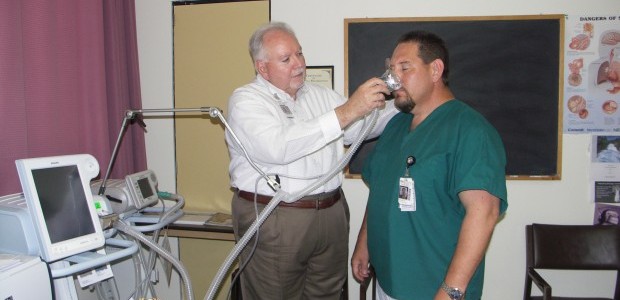
Terry Lynn Lyons Crenshaw
April 11, 2012
Installation of La. 1 toll gantry nears completion
April 11, 2012There is a reason why Leonard J. Chabert Medical Center has been named the top hospital in Louisiana for pulmonary diagnostics and respiratory care. According to Chabert Cardiopulmonary Manager Ken Duet it is the combination of having the latest technology, like a Respironics V-60 BiPAP Unit, a staff that knows how to use the new equipment and an old-fashioned level of genuine concern for the patient.
Chabert has been tagged the state’s No. 1 pulmonary and respiratory hospital, for facilities with under 200 beds, by the Louisiana Society of Respiratory Care. The designation came one week after having received the American Association of Reparatory Care quality respiratory care recognition for an eighth consecutive year on April 2. “It is quite an honor,” Duet said of both awards from the affiliated organizations.
“Superior respiratory care is essential to our overall delivery of high quality health care,” Leonard J. Chabert Medical Center CEO Rhonda Green said. “Earning [this recognition] illustrates that our respiratory care is among the best in the nation.”
“There are probably up to 5,000 hospitals in the United States and only about 500 of them get the [respiratory care recognition] each year,” AARC Associate Executive Director Sherry Milligan said. “This a small elite group. What is means for your community is that they can count on this facility giving them care from a qualified professional of respiratory care.”
“It’s all about our staff as far as I’m concerned,” Duet said of the department comprised of 25 therapists, which he has headed since June 2011. “There is a great group of therapists here that provide outstanding care. They are responsible for us being able to achieve this recognition.”
Chabert was recognized for treating respiratory care patients that range from infants to the elderly with both in-patient and out-patient services.
Duet said that one element that makes the Chabert department one of the best in Louisiana is combining expected services with respiratory education.
During his 36 year career, Duet has seen respiratory care evolve from equipment not far removed from the iron lung to microprocessor-driven respirators and ventilators.
“Technology has taken us to a point where the ventilator can analyze the patient’s breath and spit out information immediately,” Duet said. “You not only get an idea of how the patient is performing, but it is information we can take, make changes on the ventilator to better address the patient’s needs and basically assess a patient breath to breath.”
Providing the patient with information is a significant part of modern treatment. “You want to educate the patient on the disease process and the type of medications being administered, so they have a good understanding of how critical it is for them to comply [with treatments],” the Chabert department head said.
Individually, Duet has been appointed as one of seven members on the AARC Governmental Affairs Committee. He was selected, from a national pool to be a liaison representing the profession regarding public policies set by local, state and federal governments and how those policies impact respiratory patients.
Offering accolades to hospitals since 2003, the AARC’s intention is to enhance cardiopulmonary and respiratory treatment among professionals, and assist the public by educating and directing patients to the best hospitals available to meet their needs.
Duet noted that along with heart disease and cancer, chronic obstructive pulmonary disease is among the top conditions treated by doctors and hospital professionals.
“The goal in all this was to identify for the public, hospitals that employed qualified respiratory therapists,” Duet said. “The future of respiratory care is certainly technology based. I think the pharmacological advancements are incredible, but it all boils down to patient compliance, and that is where the education piece is critical.”
Duet identified being unable to breathe as “a scary experience.” He said hospitals like Chabert and professional organizations like the AARC are resources designed to eliminate the fright factor.
To be recognized among the best hospitals by the AARC, Chabert met or exceeded outlined criteria and national guidelines that include:
Bedside Respiratory care and rapid response teams
Therapists available 24 hours a day, seven days a week
Being qualified to perform scientific respiratory procedures
Meeting supervision requirements for specific procedures
A doctor of medicine or osteopathy designated medical director
Being able to diagnose lung disease and mark progression and treatment
Establishing policies for the delivery of medicated treatments
Comparing department performance with similar departments
Milligan said Chabert’s loss of infant care services to state budget cuts would not limit its ability to secure national recognition in the future. “As long as they have pulmonary respiratory therapists there with credentials available to patients on staff 24 hours a day, that is what we are asking them to verify,” she said.
The AARC was established in 1947 as a member trade organization with an objective to enhance professionalism in respiratory care. This is done by providing tools to improve performance among therapists in hospitals and home care providers.
With more than 50,000 members nationwide, the AARC is the only professional society for respiratory professionals and coordinates with educators who provide respiratory training. Duet contends Chabert Medical Center is a significant part of that award-winning tradition.
The AARC Congress will conduct its 58th international respiratory convention – billed as the largest in the world – in New Orleans on Nov. 10-13.
Leonard J. Chabert Medical Center Cardiopulmonary Manager Ken Duet, left, and respiratory and pulmonary department day supervisor Brian Thibodaux try out the new Respironica V-60 BiPAP Unit.











